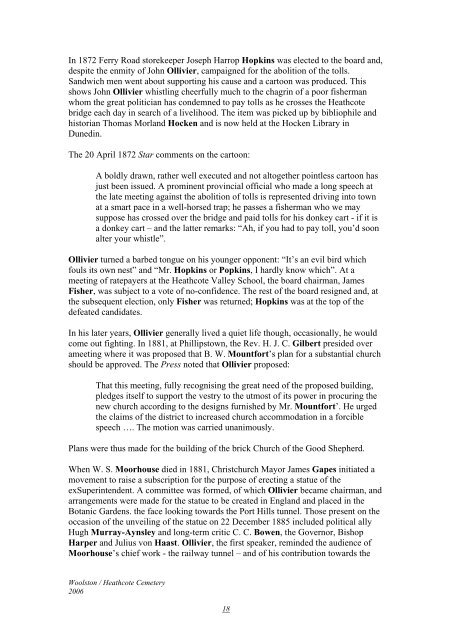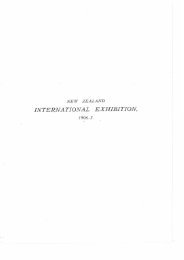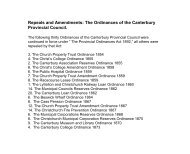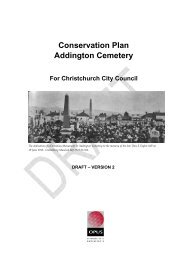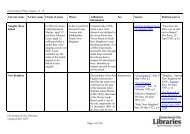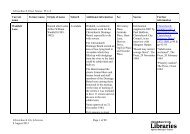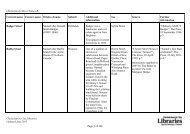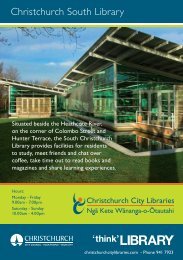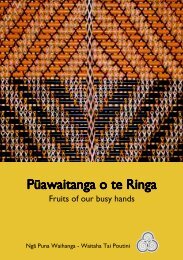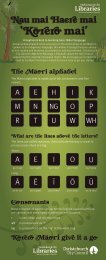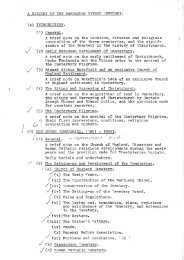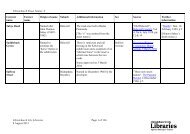Woolston / Heathcote Cemetery Tour - Christchurch City Libraries
Woolston / Heathcote Cemetery Tour - Christchurch City Libraries
Woolston / Heathcote Cemetery Tour - Christchurch City Libraries
Create successful ePaper yourself
Turn your PDF publications into a flip-book with our unique Google optimized e-Paper software.
In 1872 Ferry Road storekeeper Joseph Harrop Hopkins was elected to the board and,<br />
despite the enmity of John Ollivier, campaigned for the abolition of the tolls.<br />
Sandwich men went about supporting his cause and a cartoon was produced. This<br />
shows John Ollivier whistling cheerfully much to the chagrin of a poor fisherman<br />
whom the great politician has condemned to pay tolls as he crosses the <strong>Heathcote</strong><br />
bridge each day in search of a livelihood. The item was picked up by bibliophile and<br />
historian Thomas Morland Hocken and is now held at the Hocken Library in<br />
Dunedin.<br />
The 20 April 1872 Star comments on the cartoon:<br />
A boldly drawn, rather well executed and not altogether pointless cartoon has<br />
just been issued. A prominent provincial official who made a long speech at<br />
the late meeting against the abolition of tolls is represented driving into town<br />
at a smart pace in a well-horsed trap; he passes a fisherman who we may<br />
suppose has crossed over the bridge and paid tolls for his donkey cart - if it is<br />
a donkey cart – and the latter remarks: “Ah, if you had to pay toll, you’d soon<br />
alter your whistle”.<br />
Ollivier turned a barbed tongue on his younger opponent: “It’s an evil bird which<br />
fouls its own nest” and “Mr. Hopkins or Popkins, I hardly know which”. At a<br />
meeting of ratepayers at the <strong>Heathcote</strong> Valley School, the board chairman, James<br />
Fisher, was subject to a vote of no-confidence. The rest of the board resigned and, at<br />
the subsequent election, only Fisher was returned; Hopkins was at the top of the<br />
defeated candidates.<br />
In his later years, Ollivier generally lived a quiet life though, occasionally, he would<br />
come out fighting. In 1881, at Phillipstown, the Rev. H. J. C. Gilbert presided over<br />
ameeting where it was proposed that B. W. Mountfort’s plan for a substantial church<br />
should be approved. The Press noted that Ollivier proposed:<br />
That this meeting, fully recognising the great need of the proposed building,<br />
pledges itself to support the vestry to the utmost of its power in procuring the<br />
new church according to the designs furnished by Mr. Mountfort’. He urged<br />
the claims of the district to increased church accommodation in a forcible<br />
speech …. The motion was carried unanimously.<br />
Plans were thus made for the building of the brick Church of the Good Shepherd.<br />
When W. S. Moorhouse died in 1881, <strong>Christchurch</strong> Mayor James Gapes initiated a<br />
movement to raise a subscription for the purpose of erecting a statue of the<br />
exSuperintendent. A committee was formed, of which Ollivier became chairman, and<br />
arrangements were made for the statue to be created in England and placed in the<br />
Botanic Gardens. the face looking towards the Port Hills tunnel. Those present on the<br />
occasion of the unveiling of the statue on 22 December 1885 included political ally<br />
Hugh Murray-Aynsley and long-term critic C. C. Bowen, the Governor, Bishop<br />
Harper and Julius von Haast. Ollivier, the first speaker, reminded the audience of<br />
Moorhouse’s chief work - the railway tunnel – and of his contribution towards the<br />
<strong>Woolston</strong> / <strong>Heathcote</strong> <strong>Cemetery</strong><br />
2006<br />
18


